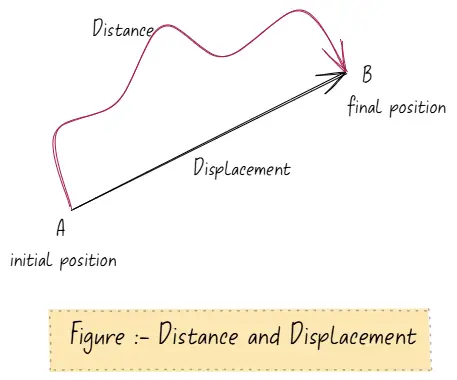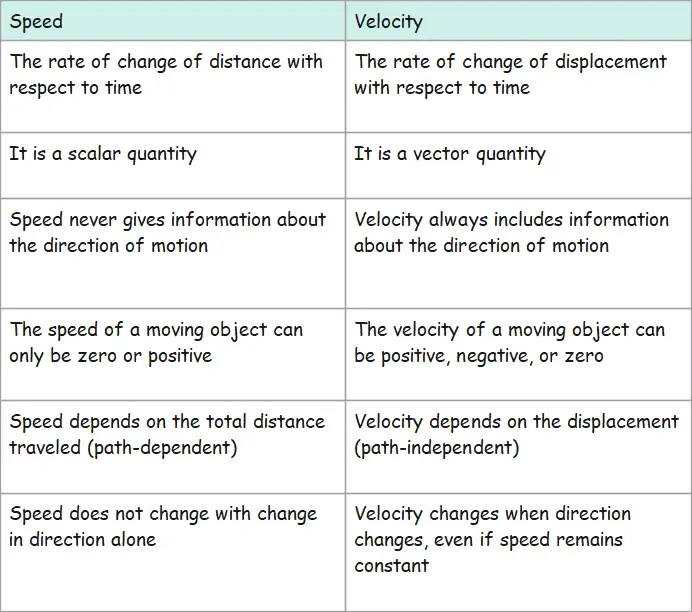In this article, you will get revision notes for topic motion in a straight-line class 11 notes for physics NCERT book chapter 2. It is important to note here that motion in a straight line is nothing but motion in one dimension. Such a type of motion is also called linear motion or rectilinear motion.
Motion in a Straight-Line Notes Physics Chapter 2
These Motion In a Straight Line notes can also be used if you are preparing for competitive exams like NEET, JEE Mains and JEE Advanced. We also have topic-wise notes on class 11 physics where you can have notes, worksheets etc for free.
Motion in a straight line notes for neet and IIT JEE
What is Kinematics
- Kinematics as we all know is the study of physical bodies (or objects) in motion without getting into the causes of that motion.
- Kinematics is the study of physical quantities such as distance, displacement, speed, velocity, and acceleration.
Introduction
- When we look around, we see various moving objects, such as people walking, automobiles driving, Ferris wheels spinning, etc.
- Everything in the universe is in motion, from Earth orbiting the Sun to the moon revolving around Earth.
- Change in the position of an object over time is defined as motion in physics.
- Both rest and motion are relative concepts.
- A body that is moving relative to one reference system may be at rest with respect to another frame of reference.
Point Object
- In the field of kinematics, the term point object is often used.
- A moving object might be considered a point object if it is very small compared to the distance it covers.
- Examples of point objects:-
(a) A car that travels 10 kilometres can be considered a “point object.”
(b) When studying how the Earth orbits the Sun, it can be viewed as a point.
Position, Distance and Displacement
Position
- When we talk about a particle’s position, we mean where it is in space at a certain point in time.
- To represent the position of a moving object at any particular time, we require a coordinate system with three mutually perpendicular axes.
- This coordinate system can be attached to the frame of reference of our choice.
- The position of a particle can be defined with respect to this frame of reference.
Distance
- Distance is the total path length travelled by the moving object.
- It is the total length of the path travelled between two positions.
- It is a scalar quantity that only has magnitude but no direction
- SI unit for measurement of distance is a meter.

Displacement
- The displacement of an object is the change in its position.
- It is the shortest distance between the object’s initial and final positions in a given direction.
- Meter is the SI unit for displacement.
- Displacement has both direction and magnitude. So it is a vector quantity.
- Its magnitude can never be greater than the total distance i.e. |Displacement|\leq Distance
- Distance and displacement are equivalent if a particle moves in a straight line without changing direction.
- It can be positive, negative or zero.
Speed
- The speed of a moving object is defined as the total distance covered divided by the time taken to cover that distance.
$$\text{Speed}=\frac{\text{Total Distance Covered}}{\text{Time Taken}}$$ - Unit of speed – In the SI system speed is measured in $m/s$. Sometimes $Km/hr$ or mile per hour $(mph)$ is also used to express speed.
- Dimensional Formula – $[M^0LT^{-1}]$
- The speed of an object can be positive or zero. It can not be negative.
- It is a scalar quantity.
Uniform Speed
- An object has constant speed if it traverses an equal distance in equal time intervals, however small these time intervals may be.
Variable Speed
- An object is considered to be moving at a variable speed if it travels the same distance in unequal time intervals, no matter how small these time intervals are.
Average Speed
- How fast an object moves
- It is defined as the total distance covered divided by the time taken to cover that distance $$\text{Average Speed}=\frac{\text{Total Distance Covered}}{\text{Time Taken}}=\frac{\Delta x}{\Delta t}$$
- Calculated when an object moves with variable speed.
Instantaneous speed
- An object moving with variable speed has different values of speed at different instances of time.
- The instantaneous speed of an object is the speed of an object at a given instant of time.
- A car’s speedometer gives us instantaneous speed.
Velocity
- How fast an object moves and in what direction.
- The velocity of an object is defined as the displacement divided by the time it takes for the displacement. Mathematically, $$Velocity=\frac{Displacement}{Time}$$
- Unit of velocity- In the SI system velocity is measured in m/s. Sometimes Km/hr or mile per hour (mph) is also used to express velocity.
- Its direction is the same as that of displacement.
- Dimensional Formula – $[M^0LT^{-1}]$
- The velocity of an object can be positive, negative or zero.
- It is a vector quantity.
Uniform Velocity
- An object is said to move with uniform velocity if it covers equal displacements in equal time intervals, no matter how small these time intervals are.
- Here both magnitude of velocity as well as the direction of velocity remains constant.
Variable Velocity
- A body is said to have had variable or non-uniform velocity if it covers unequal displacement in equal intervals of time. however small these time intervals may be.
- In this case, the magnitude of displacement, the direction of motion, or both change as time passes.
- Example:-
A body moving in a circle at a constant speed has a non-uniform velocity. This is because, even if the magnitude of the velocity remains constant, the direction of the body’s velocity changes.
Average Velocity
- It is defined as the total displacement covered divided by the time taken for that displacement $$\text{Average Velocity}=\frac{\text{Displacement}}{\text{Time Taken}} or, \bar v=\frac{\Delta \vec x}{\Delta t}$$
- The bar over v indicates average velocity.
- Calculated when an object moves with variable velocity.
Instantaneous Velocity
- The velocity of a particle at a particular instant of time is given by instantaneous velocity.
- Instantaneous velocity is also known as the limit of average velocity as the time interval becomes infinitesimally small. Mathematically instantaneous velocity, $$v=\lim_{\Delta\rightarrow0}\frac{\Delta x}{\Delta t}$$
- The limit of ratio $\frac{\Delta x}{\Delta t}$ as $\Delta t$ approaches zero is called the derivative of $x$ with respect to $t$ and is written as $dx/dt$

Acceleration
- The rate of change of velocity is called acceleration.
- The change in velocity can be in either the magnitude or the direction of the velocity, or both at the same time.
- Mathematically,$$acceleration\; \vec a=\frac{\vec v}{t}$$
- Like velocity, acceleration is a vector quantity.
- Acceleration can be negative or positive and can be zero.
- Negative acceleration is also known as deceleration or retardation.
- Uniform acceleration occurs when an object undergoes equal changes in velocity at equal time intervals.
- SI unit of acceleration is $m/s^2$
- The dimensional formula of acceleration is $[M^0L^1T^{-2}]$
Average Acceleration
- The change in velocity divided by the time interval is defined as the average acceleration over that time interval.
- It is an average change of velocity per unit of time.
- Mathematically, $$a=\frac{v_2-v_1}{t_2-t_1}$$ where, $v_2$ is velocity at time $t_2$ and $v_1$ is velocity at time $t_1$.
Instantaneous Acceleration
- The acceleration of a particle at a particular instant of time is given by instantaneous acceleration.
- It is also known as the limit of average acceleration as the time interval becomes infinitesimally small. Mathematically,$$a=\lim_{\Delta\rightarrow0}\frac{\Delta v}{\Delta t}=\frac{dv}{dt}$$
- The limit of ratio $\frac{\Delta x}{\Delta t}$ as $\Delta t$ approaches zero is called the derivative of $x$ with respect to $t$ and is written as $dv/dt$
- In the case of uniform acceleration, instantaneous acceleration equals average acceleration over that time period.
Equations of Motion
- If the particle’s velocity changes at a constant rate, this rate of change of velocity with time is referred to as the constant acceleration.
- Equations of motion link an object’s displacement to its velocity, acceleration, and time.
- Although an object’s motion can take many different trajectories but here we will concentrate on motion in a straight line (or motion in one dimension).
- We can have positive and negative displacement, velocity, and acceleration. Negative quantities point in the opposite direction as positive quantities.
- The following equations are for motion with constant acceleration $a$, initial velocity $u$, and final velocity $v$. The acceleration happens over time $t$, and the displacement from the original position is $s$.

Motion under gravity
Free Fall
- In the absence of air resistance, all bodies fall with the same acceleration near the surface of the earth.
- This motion of a body falling towards the earth from a small height is called free fall.
- The acceleration with which the body falls is called acceleration due to gravity and is denoted by $g$. ($g=9.8m/s^2$ near the surface of the earth)
Free Fall Equations of motion
- Following are the equations of motion for a freely falling body:
- $v=u+gt$
- $s=ut+\frac{1}{2}gt^2$
- $v^2-u^2=2gs$
- When a body falls freely under the action of gravity, its velocity increases and the value of g is taken as positive.
- When a body is thrown vertically upward, its velocity decreases and the value of g is taken as negative.
- For a body thrown vertically upward with initial velocity u, we have
- Maximum Height reached : $h=\frac{u^2}{2g}$
- Time of ascent = Time of descent $=\frac{u}{g}$
- Total time of flight to come back to the point of projection $=\frac{2u}{g}$
- The velocity of fall at the point of projection $=u$
- Velocity attained by the body dropped through height$h$, $v=\sqrt{2gh}$
Relative Velocity
- The relative velocity of object A with respect to object B is defined as the rate at which its (object A) position changes with respect to object B.
- Mathematically, if $\vec{v}_A$ and $\vec{v}_B$ are the velocities of object A and B respectively then the relative velocity of A with respect to B is defined as $$\vec{v}_{AB}=\vec{v}_A-\vec{v}_B$$
- Relative velocity of object B w.r.t. to object A $$\vec{v}_{BA}=\vec{v}_B-\vec{v}_A$$
- The relative velocity of two objects moving in the same direction is equal to the difference in their speeds i.e., $$\vec{v}_{AB}=\vec{v}_A-\vec{v}_B$$
- The relative velocity of two moving objects in opposite directions is the sum of their speeds i.e., $$\vec{v}_{AB}=\vec{v}_A+\vec{v}_B$$
- When $\vec{v}_A and \vec{v}_B$ are inclined to each other at an angle $\theta$, $$ \vec{v}_{AB}=\sqrt{v_A^2+v_B^2-2v_Av_B\cos\theta}$$
- If $\vec{v}_{AB}$ makes an angle $\beta$ with $v_A$, then $$\tan\beta=\frac{v_B\sin\theta}{v_A-v_B\cos\theta}$$
Visit Motion in a straight line formulas page and get all the formulas of this chapter, a pdf file is also available for download.
